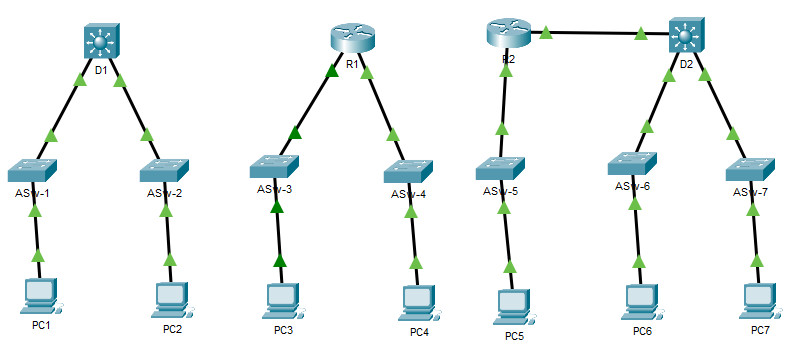11.5.1 Packet Tracer – Compare Layer 2 and Layer 3 Devices (Instructor Version)
Instructor Note: Red font color or gray highlights indicate text that appears in the instructor copy only.

Objective
- Part 1: Compare Layer 2 and Layer 3 Switches
- Part 2: Compare a Layer 3 Switch and a Router
Background
In this activity, you will use various commands to examine three different switching topologies and compare the similarities and differences between the 2960 and 3650 switches. You will also compare the routing table of a 4321 router with that of a 3650 switch.
Note: Search the internet for more details about the WS-C3650-24PS-L Layer 3 switch and the ISR 4321/K9 router.
Instructions
Step 1: Compare Layer 2 and Layer 3 Switches
a. Examine the physical aspects of D1 and ASw-1.
Each individual switch has how many physical switchports?
How many Fast Ethernet and Gigabit Ethernet switchports does each switch have?
List the transmission speed of the Fast Ethernet and Gigabit Ethernet switchports on each switch.
Are either of the two switches modular in design?
b. The switchports of a 3650 switch can be configured as Layer 3 interfaces by entering the no switchport command in interface configuration mode. This allows technicians to assign an IP address and subnet mask to the switchport in the same way that they are configured on a router interface.
What is the difference between a Layer 2 switch and a Layer 3 switch?
What is the difference between a switch’s physical interface and the VLAN interface?
At which layers do 2960 and 3650 switches operate?
Issue the show run command to examine the configurations of the D1 and ASw-1 switches. Do you notice any differences between them?
Try to display the routing table on D1 and ASw-1 using the show ip route command. Why do you think the command does not work on ASw-1 but works on D1?
Step 2: Compare a Layer 3 Switch and a Router
In the past, switches and routers have been separate and distinct devices. The term switch was set aside for hardware devices that function at Layer 2. Routers, on the other hand, are devices that make forwarding decisions based on Layer 3 information. They use routing protocols to share routing information and to communicate with other routers. Layer 3 switches, such as the 3650, can be configured to forward Layer 3 packets. Entering the ip routing command in global configuration mode allows Layer 3 switches to be configured with routing protocols, which gives them some of the capabilities of a router. Although similar in some ways, Layer 3 switches are different from routers in many other aspects.
a. Open the Physical tab on D1 and R1.
Do you notice any similarities between the two? Do you notice any differences between the two?
Issue the show run command and examine the configurations of R1 and D1. What differences do you see between the two?
Which command allows configuration of D1 with an IP address on one of its physical interfaces?
Use the show ip route command on both devices. Do you see any similarities or differences between the two tables?
Now, analyze the routing table of R2 and D2. What is present now that was not present in the configuration of R1 and D1?
Which network is in the routing table of D2 that was learned from R2?
b. Verify that each topology has full connectivity by completing the following tests:
- Ping from PC1 to PC2
- Ping from PC3 to PC4
- Ping from PC5 to PC6 and PC7
In all three examples, each PC is on a different network.
Which device is used to provide communication between networks?
Why were we able to ping across networks without there being a router?
Bonus question: We say that routers are Layer 3 devices and conventional (non-Layer 3) switches are Layer 2 devices. However, we can assign an IP address to a management (SVI) interface of a Layer 2 switch. How is this possible if switches are Layer 2 devices?
